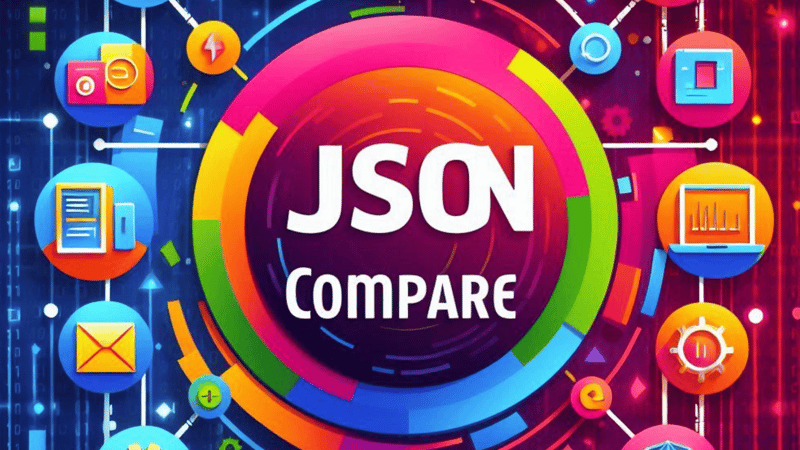
- Introduction
JSON (JavaScript Object Notation) comparison is an essential task in software development, crucial for validating data integrity and ensuring consistency across applications. As JSON continues to be the preferred format for data interchange on the web, understanding how to effectively compare JSON files is vital for developers striving to build reliable and error-free systems.
- Importance of Comparing JSON
Comparing JSON files serves several critical purposes that contribute to robust software development practices:
2.1 Data Validation and Debugging
One of the primary reasons for comparing JSON files is to validate data accuracy and facilitate debugging processes. By comparing JSON representations, developers can quickly identify discrepancies such as missing fields, incorrect values, or unexpected changes. This ensures that data exchanged between systems or stored in databases remains consistent and error-free.
2.2 Consistency Across Systems
Maintaining consistency in JSON data across different systems or versions is paramount for seamless integration and operational reliability. Comparing JSON files helps developers detect and resolve discrepancies that could arise from updates, migrations, or changes in data structures. Ensuring consistent data formats and values enhances the overall stability and functionality of applications relying on JSON data.
- Methods of Comparing JSON
Several methods exist for comparing JSON files, each suited to different scenarios and requirements:
3.1 Structural Comparison
Structural comparison focuses on validating the overall structure and format of JSON objects and arrays. It verifies that the hierarchy, order of elements, and nesting levels are identical between two JSON representations.
3.2 Value Comparison
Value comparison involves checking specific data values within JSON objects to identify differences or similarities. This method is useful for ensuring that not only the structure but also the content of JSON data remains consistent across different sources or versions.
3.3 Key Differences Detection
Key differences detection highlights changes in keys or properties between JSON files. It helps developers understand structural modifications that may impact data processing or application logic, enabling them to make informed decisions during integration or deployment phases.
- Tools for Comparing JSON
To facilitate efficient and accurate JSON comparison, developers can leverage a variety of specialized tools:
4.1 Command-Line Tools
Command-line tools provide flexibility and automation capabilities for batch processing and integration into development workflows. Tools like jq in Unix-based systems allow developers to perform JSON manipulations and comparisons directly from the terminal, streamlining repetitive tasks.
4.2 Online Comparison Tools
Web-based tools offer intuitive interfaces and interactive features for visualizing and analyzing JSON differences. Tools such as JSON Diff, JSONCompare, and JSONLint provide user-friendly platforms where developers can paste JSON data, instantly see comparisons, and delve into detailed reports highlighting discrepancies.
4.3 Programming Libraries
Programming libraries such as Gson (for Java), Newtonsoft.Json (for .NET), and Jackson (for Java) enable developers to incorporate JSON comparison directly into their applications. These libraries offer APIs for programmatically comparing JSON objects, making it easier to integrate comparison functionalities into automated testing frameworks or data synchronization processes.
- Best Practices for Effective JSON Comparison
Adopting best practices ensures thorough and reliable JSON comparison results:
5.1 Normalize JSON Formatting
Before comparing JSON files, standardize formatting to reduce discrepancies caused by whitespace or formatting variations. Consistent formatting simplifies the comparison process and improves the accuracy of detection for structural differences.
5.2 Validate Against Schema
Validate JSON files against predefined schemas to ensure adherence to data structure guidelines and enhance compatibility between different components or systems. Schema validation helps enforce data integrity rules and prevents errors resulting from invalid JSON structures.
5.3 Document and Version Control
Document JSON comparison results and implement version control practices to track changes over time effectively. Maintaining a record of JSON file versions and comparison outcomes facilitates auditing, troubleshooting, and maintaining data consistency throughout the software development lifecycle.
- Challenges and Considerations
Addressing common challenges and considerations enhances the effectiveness of JSON comparison processes:
6.1 Handling Large Datasets
Develop strategies for efficiently comparing large JSON datasets without compromising performance or accuracy. Techniques such as incremental comparison or parallel processing can mitigate challenges associated with processing extensive JSON files.
6.2 Dealing with Nested Structures
Navigate and compare nested JSON structures effectively to uncover nested differences and ensure comprehensive data validation. Recursive algorithms or specialized parsing techniques can help developers manage complex JSON hierarchies and identify subtle variations in nested data elements.
- Conclusion
Mastering JSON comparison techniques empowers developers to build robust applications with reliable data handling and seamless integrations. By implementing structured comparison methods, leveraging specialized tools, and adhering to best practices, developers can ensure data integrity, streamline debugging processes, and enhance the overall quality of software solutions.
The above is the detailed content of Compare JSON: Ensuring Data Integrity and Consistency. For more information, please follow other related articles on the PHP Chinese website!






